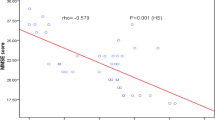Abstract
Analysis of the serum concentrations of free thyroid hormones (fT3, fT4) and thyrotropin (TSH) in 173 psychogeriatric patients (94 females and 79 males, mean age 79±8 years) disclosed that the hormone levels were related to sex, psychiatric diagnosis, medication and the presence of nonthyroid illness (NTI). Subnormal concentrations of thyroid hormones and/or TSH were found in 25% of the patients. In addition, fT3 and fT4 concentrations were significantly lower (p<0.05 and p<0.001, respectively) in demented males compared with demented females although the levels were within the reference limits. Strongly negative correlations between fT3 and age (p<0.001), and between fT3 and the sedimentation rate (SR) (p<0.01) were found in demented but not in nondemented patients. These correlations were most pronounced in (age) or restricted to (SR) demented males. In addition, the correlation between fT3 and Hb was strongly positive (p<0.001) in demented as well as in nondemented patients, particularly in males. The concentration of fT4 was positively correlated to Hb in demented males (p<0.001), whereas TSH concentration was positively correlated to Hb in demented females (p<0.05). The results show that TSH is not sufficient as the sole screening assay for evaluation of possible thyroid dysfunction in psychogeriatric patients. In addition, central (hypothalamic?) hypothyroidism may be present in a substantial amount of psychogeriatric patients, as we found an adequate TSH response to exogenous thyrotropin-releasing hormone (TRH) also in patients with decreased fT3/fT4 and no signs of non thyroid diseases. Furthermore, there was an apparent lack of correlation between thyroid hormone levels and dementia (or subgroups of dementia), even though thyroid hormone abnormalities seemed to be rather common in frontotemporal dementia (38%) and non specified dementia (36%).
Similar content being viewed by others
References
Tunbridge W.M.G., Evered D.C., Hall R., Appleton D., Brewis M., Clark F., Evans J.G., Young E., Bird T., Smith P.A.: The spectrum of thyroid disease in a community: the Whickham survey. Clin. Endocrinol. (Oxf.) 7: 481–493, 1977.
Falkenberg M., Kagedal B., Norr A.: Screening of an elderly female population for hypo- and hyperthyroidism by use of a thyroid hormone panel. Acta Med. Scand. 214: 361–365, 1983.
Wong E.T., Bradley S.G., Schulz A.L.: Elevations of thyroid-stimulating hormone during acute nonthyroid illness. Arch. Intern. Med. 141: 873–875, 1981.
Yoshimasu F., Kokmen E., Beard C.M., Offord K.P., Kurland L.T.: The association between Alzheimer’s disease and thyroid disease in Rochester, Minnesota. Neurology 41: 1745–1747, 1991.
Prasher V.P.: Age-specific prevalence, thyroid dysfunction and depressive symptomatology in adults with Down syndrome. Int. J. Ger. Psychiatr. 10: 25–31, 1995.
Evins D.L., Rossor M.N., Butler J., Roques P.K., Mullan M.J., Mc Gregor A.M.: Association between autoimmune thyroid disease and familial Alzheimer’s disease. Clin. Endocrinol. (Oxf.) 35: 93–96, 1991.
Risberg J., Gustafson L., Brun A.: High resolution regional cerebral blood flow measurements in Alzheimer’s disease and other dementia disorders. In: Maurer K., Riederer P., Beckman H. (Eds.), Key topics in brain research, 1990, pp. 509–516.
Rosén I., Gustafson L., Risberg J.: Multichannel EEG frequency analysis and somatosensory-evoked potentials in patients with different types of organic dementia. Dementia 4: 43–49, 1993.
Clarnette R.M., Patterson C.J.: Hypothyroidism: Does treatment cure dementia? J. Ger. Psychiatr. Neurol. 7: 23–25, 1994.
Parle J.V., Franklyn J.A., Cross K.W., Jones S.C., Sheppard M.C.: Prevalence and follow-up of abnormal thyrotrophin (TSH) concentrations in the elderly in the United Kingdom. Clin. Endocrinol. (Oxf.) 34: 77–83, 1991.
Cavalieri R.R.: The effects of nonthyroid disease and drugs on thyroid function tests. Med. Clin. North Am. 75: No. 1, January 1991.
Caradoc-Davies T.H., Loan P., Campbell A.J.: Why are the sensitive TSH assay and TRH stimulation test frequently low in very old euthyroid patients? N. Z. Med. J. 101: 662–663, 1988.
Mariotti S., Barbesino G., Caturegli P., Bartalena L., Sansoni P., Fagnoni F., Monti D., Fagiolo U., Franceschi C., Pinchera A.: Complex alterations of thyroid function in healthy centenarians. J. Clin. Endocrinol. Metab. 77: 1130–1134, 1993.
Jackson I.M.D.: Thyrotropin-releasing hormone. N. Engl. J. Med. 306: 145–155, 1982.
Wartofsky L., Burman K.D.: Alterations in thyroid function in patients with systemic illness: “The euthyroid-sick syndrome.” Endocr. Rev. 3: 164–217, 1982.
Mariotti S., Franceschi C., Cossarizza A., Pinchera A.: The aging thyroid. Endocr. Rev. 16: 686–712, 1995.
Lindstedt G., Edén S., Jagenburg R., Lundberg P.A., Mellström D., Odén A., Svanborg A.: Factors influencing serum free T4 in 70-year-old men. Implications for reference intervals in the elderly. Scand. J. Clin. Lab. Invest. 43: 401–413, 1983.
Hurley J.R.: Thyroid disease in the elderly. Med. Clin. North Am. 67: 497–516, 1983.
Ordene K.W., Pan C., Barzel U.S., Surks M.I.: Variable thyrotropin response to thyrotropin-releasing hormone after small decreases in plasma thyroid hormone concentrations in patients of advanced age. Metabolism 32: 881–888, 1983.
Lindstedt G., Tisell L.E., Nyström E., Petersen K., Jagenburg R., Lundberg P.A.: Thyroid function evaluation in the mid 80’s (Letter). Scand. J. Clin. Lab. Invest. 44: 465–470, 1984.
Klee G.G., Hay I.D.: Assessment of sensitive thyrotropin assays for an expanded role in thyroid function testing: proposed criteria for analytic performance and clinical utility. J. Clin. Endocrinol. Metab. 64: 416–471, 1987.
Author information
Authors and Affiliations
Rights and permissions
About this article
Cite this article
Fäldt, R., Passant, U., Nilsson, K. et al. Prevalence of thyroid hormone abnormalities in elderly patients with symptoms of organic brain disease. Aging Clin Exp Res 8, 347–353 (1996). https://doi.org/10.1007/BF03339592
Received:
Accepted:
Published:
Issue Date:
DOI: https://doi.org/10.1007/BF03339592



